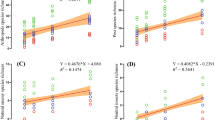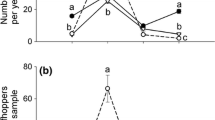Abstract
‘Generalists’, i.e. those species which consume a wide variety of foods, including some of plant origin such as pollen, are the dominant members of the phytoseiid mite fauna in some perennial crops. Biological attributes commonly evident in ‘generalist’ in contrast to ‘specialist’ phytoseiids include a lower reproductive potential on mite prey, close association with certain plant species, population increases in the absence of mite prey, and intraplant distribution unrelated to that of spider mites. Some studies are reviewed that suggest the ability of certain generalist phytoseiids to maintain tetranychid populations at low densities. Possible biological factors influencing the establishment of exotic generalist phytoseiids are considered. Some of the attributes usually considered important in effective phytoseiid predators may be of minor importance in more stable situations at low population densities.
Similar content being viewed by others
References
Abou-Setta, M.M. and Childers, C.C., 1989. Biology ofEuseius mesembrinus (Acari: Phytoseiidae): Life tables and feeding behavior on tetranychid mites on citrus. Environ. Entomol., 18: 665–669.
Bounfour, M. and McMurtry, J.A., 1987. Biology and ecology ofEuseius scutalis Athias-Henriot (Acarina: Phytoseiidae). Hilgardia, 55: 1–23.
Calis, J.N.M., Overmeer, W.P.J. and van der Geest, L.P.S., 1988. Tydeids as alternative prey for phytoseiid mites in apple orchards. Internat. Symp. on Crop Protection, part 2. Meded. Fac. Landbouwwet Rijksuniv. Gent., 53 (2 Part B): 793–798.
Chant, D.A., 1959. Phytoseiid mites (Acarina: Phytoseiidae). I. Bionomics of seven species in south-eastern England. II. A taxonomic review of the family Phytoseiidae, with descriptions of thirty-eight species. Can. Entomol., 91: Suppl. 12, 166 pp.
Collyer, E., 1964. A summary of experiments to demonstrate the role ofTyphlodromus pyri Scheut. in the control ofPanonychus ulmi (Koch) in England. Acarologia, (Compt. Rend. Ier Intern. Congr. Acarol., Fort Collins, Colo., U.S.A., 1963): 363–371.
Collyer, E. and Kirby, A.H.M., 1955. Some factors affecting the balance of phytophagous and predacious mites on apple in south-east England. J. Hortic. Sci., 34: 39–50.
Congdon, B.D., 1985. Distribution and ecology of CaliforniaEuseius species (Acari: Phytoseiidae). Ph.D. dissertation, Univ. of California, Riverside, CA, 117 pp.
Congdon, B.D. and McMurtry, J.A., 1986. The distribution and taxonomic relationships ofEuseius quetzali in California (Acari: Phytoseiidae). Int. J. Acarol., 12: 7–12.
Dicke, M., 1988. Infochemicals in tritrophic interactions. Origin and function in a system consisting of predatory mites, phytophagous mites and their host plants. Ph.D. thesis, Agricultural University, Wageningen, Netherlands.
Dicke, M. and de Jong, M., 1988. Prey preference of the phytoseiid miteTyphlodromus pyri. 2. Electrophoretic diet analysis. Exp. Appl. Acarol., 4: 15–26.
Dicke, M., Sabelis, M.W., de Jong, M. and M. Alers, P.T., 1990. Do phytoseiid mites select the best prey species in terms of reproductive success? Exp. Appl. Acarol., 8: 161–173.
Dunley, J.E. and Croft, B.A., 1990. Dispersal between and colonization of apple byMetaseiulus occidentalis andTyphlodromus pyri (Acarina: Phytoseiidae). Exp. Appl. Acarol., 10: 137–149.
Duso, C., 1988. Minimum release ofKampimodromus aberrans (Oud.) to control tetranychid mites on grapevine. Preliminary reports. In: R. Cavalloro (Editor), Influence of Environmental Factors on the Control of Grape Pests, Diseases and Weeds, Proc. Mtg. E.C. Experts Grp., Thessaloniki, Greece, 1987. A.A. Balkema, Rotterdam.
Duso, C., 1989. Role of the predatory mitesAmblyseius aberrans (Oud.),Typhlodromus pyri Scheuten andAmblyseius andersoni (Chant) (Acari: Phytoseiidae) in vineyards. 1. The effects of single or mixed phytoseiid population releases on spider mite densities (Acari: Tetranychidae). J. Appl. Entomol., 107 (5): 474–494.
Ferragut, F., Garcia Mari, F., Costa Comelles, J. and Laborda, R., 1987. Influence of food and temperature on development and oviposition ofEuseius stipulatus andTyphlodromus phialatus (Acari: Phytoseiidae). Exp. Appl. Acarol., 3: 317–330.
Gruys, P., 1982. Hits and misses: the ecological approach to pest control in orchards. Entomol. Exp. Appl., 31: 70–87.
Helle, W. and M. Sabelis, W. (Editors) 1985. Spider Mites: Their Biology, Natural Enemies and Control, Vol 1B. Elsevier, Amsterdam, 458 pp.
Ivancich Gambaro, P., 1986. An ecological study ofAmblyseius andersoni (Chant) (Acarina: Phytoseiidae) in the climate of the Po Valley (North Italy). Long-term research on OP-resistant populations. Redia, 69: 555–572.
James, D.G., 1989: Influence of diet on development, survival and oviposition in an Australian phytoseiid,Amblyseius victoriensis (Acari: Phytoseiidae). Exp. Appl. Acarol., 6: 1–10.
James, D.G., 1990. Biological control ofTetranychus urticae (Koch) (Acari: Tetranychidae) in southern New South Wales peach orchards: the role ofAmblyseius victoriensis (Acari: Phytoseiidae). Aust. J. Zool., 37: 645–655.
Keetch, D.P., 1972. Ecology of the citrus red mite,Panonychus citri (McGregor) (Acarina: Tetranychidae) in South Africa. 3. The influence of the predaceous mite,Amblyseius (Typhlodromalus) addoensis van der Merwe & Ryke. J. Entomol. Soc. S. Afr., 35: 69–79.
Kennett, C.E., Flaherty, D.L. and Hoffmann, R.W., 1979. Effect of wind-borne pollens on the population dynamics ofAmblyseius hibisci (Acarina: Phytoseiidae). Entomophaga, 24: 83–98.
McMurtry, J.A., 1969. Biological control of citrus red mite in California. Proc. 1st Intern. Citrus Sym., 2: 855–862.
McMurtry, J.A., 1977. Some predaceous mites (Phytoseiidae) on citrus in the Mediterranean region. Entomophaga, 22: 19–30.
McMurtry, J.A., 1982. The use of phytoseiids for biological control: Progress and future prospects. In: M.A. Hoy (Editor), Recent Advances in Knowledge of the Phytoseiidae, Publ. 3284. University of California Press, Berkeley, pp. 23–48.
McMurtry, J.A., 1985. Avocado. In: W. Helle and M.W. Sabelis (Editors), Spider Mites: Their Biology, Natural Enemies and Control. Elsevier, Amsterdam, pp. 327–332.
McMurtry, J.A., 1989. Utilizing natural enemies to control pest mites on citrus and avocado in California, U.S.A. In: C.P. Channabasavanna and C.A. Viraktamath (Editors), Progress in Acarology, Proc. VII Int. Cong. Acarol. Oxford and I.B.H., New Delhi, Vol. 2, pp. 325–336.
McMurtry, J.A. and Johnson, H.G., 1965. Some factors influencing the abundance of the predaceous miteAmblyseius hibisci in southern California (Acarina: Phytoseiidae). Ann. Entomol. Soc. Am., 58: 49–56.
McMurtry, J.A. and Johnson, H.G., 1966. An ecological study of the spider miteOligonychus punicae (Hirst) and its natural enemies. Hilgardia, 37: 363–402.
McMurtry, J.A. and Rodriguez, J.G., 1987. Nutritional ecology of phytoseiid mites. In: F. Slansky Jr. and J.G. Rodriguez (Editors), Nutritional Ecology of Insects, Mites and Spiders. John Wiley, New York, NY, pp. 609–644.
McMurtry, J.A. and Scriven, G.T., 1964. Studies on the feeding, reproduction and development ofAmblyseius hibisci (Acarina: Phytoseiidae) on various food substances. Ann. Entomol. Soc. Am., 57: 649–655.
McMurtry, J.A. and Scriven, G.T., 1966a. The influence of pollen and prey density on the number of prey consumed byAmblyseius hibisci (Acarina: Phytoseiidae). Ann. Entomol. Soc. Am., 59: 147–149.
McMurtry, J.A. and Scriven, G.T., 1966b. Studies on predator-prey interactions betweenAmblyseius hibisci andOligonychus punicae (Acarina: Phytoseiidae, Tetranychidae) under greenhouse conditions. Ann. Entomol. Soc. Am., 59: 793–800.
McMurtry, J.A. and van de Vrie, M., 1973. Predation byAmblyseius potentillae onPanonychus ulmi in simple ecosystems (Acarina: Phytoseiidae, Tetranychidae). Hilgardia, 42: 17–34.
McMurtry, J.A., Johnson, H.G. and Badii, M.H., 1984. Experiments to determine effects of predator releases on populations ofOligonychus punicae on avocado in California. Entomophaga, 29: 11–19.
McMurtry, J.A., de Moraes, G.J. and Johnson, H.G., 1992. Arrestment responses of some phytoseiid mites to extracts ofOligonychus punicae, Tetranychus urticae and pollen. Israel J. Entomol., 25–26: 29–34.
Nyrop, J.P., 1988. Spatial dynamics of an acarine predator-prey system:Typhlodromus pyri (Acari: Phytoseiidae) preying onPanonychus ulmi (Acari: Tetranychidae). Environ. Entomol., 17: 1019–1031.
Osakabe, M., 1988. Relationships between food substances and developmental success inAmblyseius sojaensis Ehara (Acarina: Phytoseiidae). Appl. Entomol. Zool., 23: 45–51.
Porres, M.A., McMurtry, J.A. and March, R.B., 1975. Investigations of leaf sap feeding by three species of phytoseiid mites by labelling with radioactive phosphoric acid ((H3 32PO4). Ann. Entomol. Soc. Am., 68: 871–872.
Putman, W.L., 1962. Life-history and behavior of the predacious miteTyphlodromus (T.) caudiglans Schuster (Acarina: Phytoseiidae) in Ontario, with notes on the prey of related species. Can. Entomol., 94: 163–177.
Ragusa, S., 1981. Influence of different kinds of food substances on the developmental time in young stages of the predacious miteTyphlodromus exhilaratus Ragusa (Acarina: Phytoseiidae). Redia, 64: 237–243.
Ragusa, S. and Swirski, E., 1977. Feeding habits, post-embryonic and adult survival, mating, virility and fecundity of the predacious miteAmblyseius swirskii (Acarina: Phytoseiidae) on some coccids and mealybugs. Entomophaga, 22: 383–392.
Sabelis, M.W., 1981. Biological control of two-spotted spider mites using phytoseiid predators. Modelling the predator-prey interactions at the individual level. Agric. Res. Rep. 910. PUDOC, Wageningen, Netherlands.
Sabelis, M.W., 1985. Capacity for population increase. In: W. Helle and M.W. Sabelis (Editors), Spider Mites: Their Biology, Natural Enemies and Control. Vol. 1B. Elsevier, Amsterdam, pp. 35–41.
Sabelis, M.W. and van de Baan, H.E., 1983. Location of distant spider mite colonies of phytoseiid predators: demonstration of specific kairomones emitted byTetranychus urticae andPanonychus ulmi. Entomol. Exp. Appl., 33: 303–314.
Tanigoshi, L.K., Fargerlund, J. and Nishio-Wong, J.Y., 1981. Significance of temperature and food resources to the developmental biology ofAmblyseius hibisci (Chant) (Acarina: Phytoseiidae). Z. Ang. Entomol., 92: 409–419.
Wearing, C.H., Walker, J.T.S., Collyer, E. and Thomas, W.P., 1978. Integrated control of apple pests in New Zealand. 8. Commercial assessment of an integrated control programme against European red mite using an insecticide-resistant predator. N.Z.J. Zool., 5: 823–837.
Zhao, Z. and McMurtry, J.A., 1990. Development and reproduction of threeEuseius (Acari: Phytoseiidae) species in the presence and absence of supplementary foods. Exp. Appl. Acarol., 8: 233–242.
Author information
Authors and Affiliations
Rights and permissions
About this article
Cite this article
McMurtry, J.A. Dynamics and potential impact of ‘generalist’ phytoseiids in agroecosystems and possibilities for establishment of exotic species. Exp Appl Acarol 14, 371–382 (1992). https://doi.org/10.1007/BF01200574
Issue Date:
DOI: https://doi.org/10.1007/BF01200574




